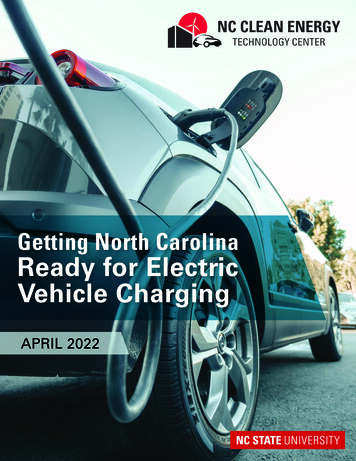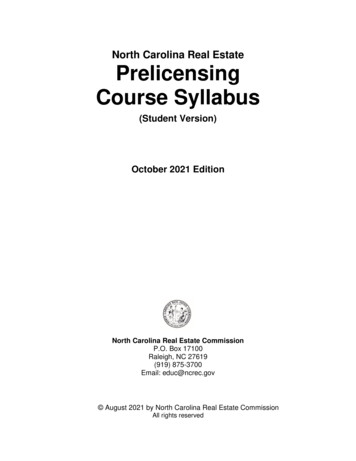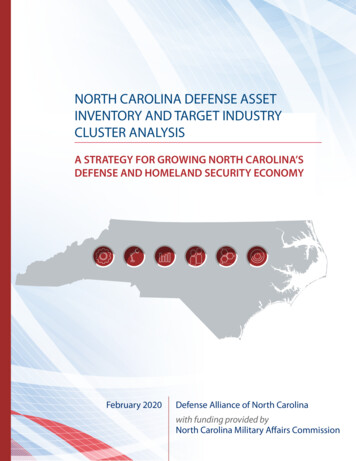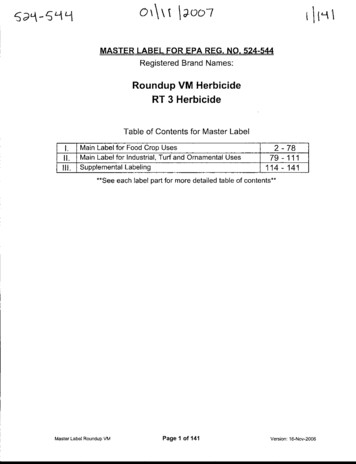
Transcription
Getting North CarolinaReady for ElectricVehicle ChargingAPRIL 2022
SUMMARYHow to Get North CarolinaReady For The ElectricVehicle RevolutionElectrification of transportation isexciting and challenging. Market forcesare already pushing us in the directionof electric vehicles, but our electric“refueling” infrastructure is lagging.Investments are being made andmore are coming in the form of grants,incentives, and substantial federalinvestments. Our challenge here inNorth Carolina is to prepare nowfor this influx of funding, to ensurewe are ready for it, and that we useit effectively and efficiently. Thisguidance document helps the readerunderstand how to get ready and whereto find detailed guides for differentaspects of building the new EV charginginfrastructure.Automobile manufacturers are announcing their electric vehicle (EV) production plans onnearly a daily basis. Within a very short period of time, there will be a wide variety of EVs inthe showrooms of every major brand. Cars, trucks, and SUVs powered by electric motors andrechargeable batteries will soon be available for purchase by consumers in North Carolinaand the rest of the US. Even fleets have expanding EV options as electric school buses,transit buses, LTVs, and medium- and heavy-duty work trucks become truly commercialized.Will North Carolina be ready with the public EV charging infrastructure that electric vehiclebuyers need to feel comfortable with the idea of owning and traveling with an EV?For homeowners, charging is typicallyeasier than for apartment dwellersMost North Carolina EV owners who owntheir own homes have off-street parking andwill have no problem charging their EV’sbatteries with a charger or cord installed attheir residence. These people can chargeeach night and be ready to go the next daywith a full charge.What about drivers without dedicatedoff-street parking, apartment and condodwellers, or those taking a long trip?Most apartment, townhome, and condo dwellers in North Carolina don’t currently have aplace to charge where they live. Many homeowners in dense neighborhoods lack off-streetparking and the ability to charge. Also, those EV owners who need to travel beyond therange of their EV’s battery also face difficulty finding a place to charge along the way.North Carolina State University College of Engineering 919-515-3480 www.nccleantech.ncsu.edu
However, public charging can provide a chargingoption for both of those use cases. A recent study fromthe University of California – Los Angeles found thatdrivers who live in multi-family housing largely rely onDC fast chargers.1 Another report from the InternationalCouncil on Clean Transportation reached a similarconclusion, that EV-owning apartment dwellers in theU.S. rely primarily on public charging sites.2North CarolinaFocused: LocallySourced GuidesLook out for this icon to findfour locally produced guides,which are based on specificcircumstances and regulationswithin the state of North Carolina.Respondent Primary Charging ModeCharging at work is a breezeWhile most EV charging happens at places of residence,workplace charging is also very important. According to theU.S. Department of Energy, people who are able to chargeat work are six times more likely to drive an EV than thosewithout the option.3 Workplace charging especially helpsEV drivers who don’t have access to home charging,or whose commute is long. Workplace charging canalso help businesses attract and retain talent, improveemployee productivity, and achieve sustainability goals—typically at very little or no cost to the workplace. In sum,ensuring access to charging at long dwell-time locations,like workplaces, is even more important for driverswithout access to dedicated overnight parking and willbecome increasingly important as managed charging andbidirectional charging become more widespread.University of California at Los Angeles, Luskin Center for Innovation, Evaluating Multi-Unit ResidentCharging Behavior at Direct Current Fast Chargers, January 2021, available ternational Council on Clean Transportation, Quantifying the Electric Vehicle Charging Infrastructure GapAcross U.S. Markets, January 2019, page 9; available at ns/US charging Gap 20190124.pdf3US Department of Energy, “Workplace Charging Challenge Progress Update 7/01/f34/WPCC 2016%20Annual%20Progress%20Report.pdf1North Carolina State University College of Engineering 919-515-3480 www.nccleantech.ncsu.edu
“As we transition our own fleets to electric, there is an opportunity to sharethe responsibility and create public / private partnerships that benefit ourfleets and can also be used by the public. Local governments will own someEV infrastructure for our fleets, but just like gas stations, we also rely onprivate infrastructure— especially for our longer route vehicles and/or thoseon the outskirts of town. This is something we’re working on in Raleigh.”—Megan Anderson, Sustainability Manager, City of Raleigh.Public EV charging infrastructure is a pressing needCreating more publicly available EV charging stations will help increase confidence of thoseconsidering buying electric vehicles. As beneficial for the environment as EVs may be, thereare currently some significant limitations in the area of EVSE availability and convenience: It takes longer to charge an EV than it does to gas up a conventional car (althoughcharge times are declining as technologies advance). The quantity of public EV charging stations is nowhere near that of gas stations. Not all EV charging stations are compatible with different types of EVs that can charge atthem (i.e., CCS Combo, J1172, Tesla, and ChaDeMO). Not all EV charging stations are compatible with different payment systems, which maypresent friction for some users. Some stations may be closed, not working, or in use when a driver arrives to recharge.Building and installing more well-planned EV chargers helps solve all these problems.The state of EV charger deployment in North CarolinaAccording to a recent study of EV and EVSEdeployment in the Southeastern states, NorthCarolina is ranked behind Georgia and Florida inEV charging ports per 1,000 people.4 In anotherstudy from 2018, the Tarheel State was ranked 10thin the nation in total deployed charging stations butonly 30th in charging stations per capita.5Currently, there are 979 publicly available EVcharging stations throughout NC, with mostcounties having fewer than 20. Areas with higherconcentrations of charging stations are mostlyclustered around the Raleigh-Durham and Charlottemetropolitan areas. Of these 979 stations, only 451are DC Fast charging stations. Altogether, betweenpublic Level 2 and DC Fast, there are only 2,361ports in North Carolina.Accessibility forPublic ChargingStations, Version 2.0,November 2014This guide, produced by AdvancedEnergy, is based on international,Federal, and North Carolina codesand standards governing bothEVSE installation and guidelines foraccessibility under the ADA.LEARN MORETransportation Electrification in the Southeast, Atlas Public Policy, August 2021, 021.pdf5Which States Love Electric Vehicles the Most? James McCrea, October 03, 2018, ic-vehicles4North Carolina State University College of Engineering 919-515-3480 www.nccleantech.ncsu.edu
Installed Electric Vehicle Charging Stations byNorth Carolina County (data from afdc.energy.gov)Bottom line? It is essential that an expandedCharging Stationfocus by vehicle manufacturers to produceHandbook for Electricalmore EVs is complemented by a similarly rapidContractors andexpansion in EV charging around the country. AndInspectors, Version 4.0,if North Carolina is to meet our ambitious goal ofNovember 20141.25 million EVs by 2030, we must accelerate ourdeployment of all types of EV charging stations.This handbook, produced byAdvanced Energy, includesThe good news is that Efforts are underwayoverviews, guidelines and checklistsacross the state tohelp is on the way!to help contractors and inspectorsincrease the density ofdeal with requests relating to EVSE.charging stations in the hopes of encouraging anA sampling of topics covered:increase in both public and private use of electricvehicles. Some recent developments have done1. Charging Levelsmuch to boost the pace of public EV charging2. Codes & standardsinfrastructure deployment. One is the Volkswagen3. Installation locationsdiesel emissions scandal consent decree, aka the4. Installation preparationVW Settlement, which has provided 2 billion to5. Charging station selectionpromote EV use in the US through the end of 2026.6. Installation & InspectionThe Electrify America EV charging system plansto draw on these funds to build out a network ofLEARN MOREcharging stations across the US that will ultimatelybe located within 70 miles of each other.Another tailwind for EV charging development has come from the incoming Bidenadministration, which strongly supports the switch to EVs as well as an accelerated buildoutof the EV charging system nationwide. This is now a national “green infrastructure” priority,with numerous grants, tax credits, and rebates available – and much more likely to beadded. The Bipartisan Infrastructure Law includes 7.5 billion to deploy a nationwidenetwork of 500,000 EV chargers. 5 billion of this will be made available under the NationalElectric Vehicle Infrastructure (NEVI) Formula Program.For North Carolina, most of these funds will be administered through NCDOT. So, the stateis well-positioned to see a dramatic increase in EV charging developments. Additional tools,such as commercial EV electricity rates, and Duke Energy’s make-ready program, are otherways that North Carolina will leverage private sector investment in EV infrastructure.Our challenge here in North Carolina is to prepare now for this influx of funding,to ensure we are ready for it, and that we use it effectively and efficiently.North Carolina State University College of Engineering 919-515-3480 www.nccleantech.ncsu.edu
Multifamily ElectricVehicle Charging GuideThis guide from Plug-in NCtakes you through the process ofcreating EV charging stations formultifamily communities:1. Finding a location2. Assessing your electrical access3. Selecting charging equipment4. Preparing for installation5. Developing policy & etiquetteguidelines6. Promoting the stations &educating residentsNorth Carolina is doing its partLEARN MOREIn North Carolina, there is much being done at thestate and local levels. Governor Cooper’s ExecutiveOrder 246 (EO246) sets an ambitious goal of 1.25 million zero emission vehicles on NC roadsby 2030. In 2019, the North Carolina Clean Energy Technology Center (NCCETC) provided 2.8 million in grant funds through the Clean Fuel Advanced Technology (CFAT) Project.The CFAT program helped fund 11 electric vehicle charging station projects, delivering 53new Level 2 EV charging ports (28 of which are replacements of defunct equipment), 16solar-powered EV charging ports and 4 new DC Fast Charge ports (at two stations). Readmore about these projects (and others) here.In addition, NC Department of Environmental Quality (DEQ) has awarded more than 3.8million in funds to EV charging infrastructure as a part of the VW settlement. A total of 422,000 was awarded for Level 2 charging in February of 2021, resulting in 96 ports at 29locations, and 3,434,974 was awarded for DC Fast chargers in July of 2020, resulting in48 ports at 32 locations. In December 2021, NC DEQ issued their plan for VW Phase 2, andyou can learn more about how they will utilize the remaining funding online by clicking here.Duke Energy is also part of the Electric Highway Coalition, a group of six regional utilitiesthat plan a network of charging stations along the major highways that connect the South,Gulf Coast, Midwest, and Central Plains.Duke Energy is also well on their way to deploying a 25 million plan which includes theinstallation of 160 public Level 2 and 40 public fast-charging stations at 20 locations. In its2020 decision authorizing this funding, the North Carolina Utilities Commission also orderedfuture programs to consider more ways to leverage private sector investment such asmake-ready programs.6In addition to Duke Energy, member-owned electric cooperatives in the state have beenaccelerating their own investments in Level 2 and DC fast charging stations. NC electriccoops are making these investments both independently and in partnership with NC DEQ’sVW settlement program.Order Approving Electric Transportation Pilot, In Part, November 24, 2020, https://starw1.ncuc.net/NCUC/ViewFile.aspx?Id f0f2e564-51fa-46fb-a156-5b04f301db0f6North Carolina State University College of Engineering 919-515-3480 www.nccleantech.ncsu.edu
It’s a start, but much more must be done – here are the tools we need!A successful switchover from internal combustion engine (ICE) vehicles to EVs will taketime, but there is plenty that can happen now at the local level. For all the North Carolinaplanners, code enforcement officials, sustainability officers, grant writers, public works staff,fleet managers, and parking administrators out there, we have some excellent planning andexecution tools that you can use to get the results that we all need.“Where can Icharge my carwhile towing atrailer?”“Electric motorcycles aregrowing in popularity,but they take up a wholespace— can we plansites better to allow bikesized spaces?”“Electric box trucks,delivery vans, and mediumduty work trucks will alsoneed to be charged— howdo we plan for them?”The Guide to the GuidesIs Your Complete Handbook toMunicipal EV Charging ResourcesAfter reviewing numerous guides for local governments on the complexities of EV chargersand deploying them, we think we’ve found the best single resource. The Cadmus Group,in collaboration with the US Department of Energy procurement team, has developedFleets for the Future: Guide to the Guides – Municipal EV Charging Resources. This 28page document is a curated collection of highly practical EV charging guides, tools, andprocurement contracts that can help with municipal EV charging strategies and EVSEprocurement.Fleets for the Future is a U.S. Department of Energy-funded aggregate procurementinitiative that aims to reduce the cost of deploying alternative fueled vehicles and associatedinfrastructure (e.g. EV charging stations) for public fleets nationwide. It has developedEVSE contracts that can be leveraged via rider clauses by any public or nonprofit fleetthrough Sourcewell, a cooperative purchasing program that serves government, educationand nonprofit organizations.Fleets for the Future: Guide to the Guides has been designed as a quick referenceresource to provide an orientation to EV charging guides and tools that can help with EVinfrastructure planning. This includes strategies for direct public investment in EVSE, policyformation to support EV charging network development, and opportunities for collaborationwith utilities on EV charging goals.North Carolina State University College of Engineering 919-515-3480 www.nccleantech.ncsu.edu
There are other cooperativeprocurement programs that localgovernments should be aware of:In collaboration with the Climate Mayors,Sourcewell offers special group-purchasecontracts and lease arrangements for EVsand associated equipment. Also, the NorthCarolina Department of Administrationand the NC Sheriff’s Association havefavorable contract pricing and bid awardsavailable to local governments.The resources compiled in Fleets for theFuture: Guide to the Guides may be useful forplanning and zoning departments, municipalfleet managers and procurement specialists,utilities, and other stakeholders involved inhands-on implementation and policy effortsto increase EV and EVSE deployment.Expected use cases include: Selection of an appropriate tool for EVcharging needs assessment Identification of EVSE procurementopportunities and suggested equipmentLEARN MOREspecifications Education of stakeholder groups interestedin further developing EV charging networks Identification of targeted resources for keyaspects of EVSE implementation like sitingand designLEARN MORE The creation of multi-family or workplacecharging programsThe document includes a list of 50 EVcharging guides and a list of sevenquantitative and spatial EV charging tools.The tables listing the resources are organizedLEARN MOREby highlighting how each resource can servevarious information categories within threemain EVSE deployment strategies.Using the columns in the table included inThe following categories are used:Fleets for the Future: Guide to the Guides,users can quickly focus on EV chargingStrategies for direct public investmentguides that address their topics of interest Planningmost directly. Colored blue squares Siting & designwithin the strategy grid indicate how in Finances & operationsdepth each category is covered within the Medium & heavy-duty vehiclescorresponding document, with the darkestblue providing the most coverage.Strategies for enabling EVSE growthListings in the table include hyperlinks EVSE incentivesto the document, author, and year of Soft costspublication. Summaries of each resource Workplace/multifamilyare also included below the table.Preview the first part of the “List of EVCharging Guides” table on the next page.Find the full table starting on page 7 ofFleets for the Future: Guide to the Guides.Strategies for utility coordination Utility policy Managing costs & grid impactNorth Carolina State University College of Engineering 919-515-3480 www.nccleantech.ncsu.edu
List of EV Charging GuidesFleets for the Future: Guide to the Guides also includes appendicesthat provide access to past Fleets for the Future webinars, as wellas relevant podcasts on a variety of EV-related topics.Also provided in these appendices are procurementresources which enable the purchases of EVSE at low cost.These cooperative purchasing contracts were developedthrough the Fleets for the Future project. Municipalities,state agencies, public and quasi-public agencies, otherpublic entities such as libraries, schools, and hospitals, andnonprofits are all eligible to purchase the following productsand services through these contracts: EVSE hardware WarrantiesYou can download the full(Level 1, Level 2, and Installation28-pages of Fleets for theDCFC) NetworkingFuture: Guide to the Guides Maintenance Charging monitoringby clicking the link below. Repair Billing Parts Other relatedDOWNLOAD Leasingsoftware servicesNorth Carolina State University College of Engineering 919-515-3480 www.nccleantech.ncsu.edu
ADDENDUMIn the final days before publication of thisguidance document, we learned of severalvaluable new guides that are worth highlighting.In February, USDOT released ChargingForward: A Toolkit for Planning and FundingRural Electric Mobility Infrastructure, a verygood toolkit especially for rural communities. Itcan help connect community members, towns,businesses, planning agencies, and otherswith partners needed to build this EV charginginfrastructure. It contains best practices forplanning EV charging networks and tips tonavigate federal funding and financing to helpmake these projects a reality. Find the link todonwload below along with two sections we’dlike to highlight!Workplace ElectricVehicle Charging GuideThis Plug-in NC guide takesyou through the steps of creatingEV charging stations for employers:1. Developing a charging strategy2. Survey employees3. Review electrical access &select parking spaces4. Select charging stations5. Hire a contrator6. Install & inspect equipment7. Add way-finding signage8. Create a policy9. Promote your stations10. Use your dataLEARN MORELEARN MOREEV InfrastructurePlanning for Rural AreasREAD MOREResources for EVInfrastructure PlanningREAD MOREState and local officials should also address the “soft costs” that can slow the development of EVchargers. In order to meet NC and the Biden Administration’s transportation electrification goals,these stakeholders will need to break down the current barriers to faster charger development.The current process of bringing a fast charger online takes an average of 18 months, but withproper planning and alignment can be streamlined to just six months. EVgo’s Connect the Wattsinitiative recently released a series of best practice guides for public funding, utilities and localpermitting to provide solutions to some of these challenges.Process improvements may also include streamlined utility processes to ensure timelyenergization of third-party EV installs, as well as statewide permitting ordinances and/or guidance.New Jersey recently passed legislation that created a statewide ordinance for EV charging, whichwill help expedite charging deployments. For more information, click the link below.LEARN MORENorth Carolina State University College of Engineering 919-515-3480 www.nccleantech.ncsu.edu
In October 2021, a noteworthy Public FleetElectrification Guide was published bySourcewell, the cooperative purchasing andleasing organization. This twelve page guideis short, crisp, and easy to read with anoverview of the challenge and helpful Mythsvs Facts format to guide newcomers to thissubject. This is a very good starting point forthe municipal officer or public fleet managerwho is just beginning to learn about EVs.The reader will Understand the current capabilities of EVs Navigate speed bumps to public fleetelectrification Access data, tools, & resources to drivedecisionsAnother powerful new is resource is theRegional EV Charging InfrastructureLocation Identification Toolkit (ILIT). TheILIT toolkit includes three tools — theILIT Model, Results Mapper, and DataViewer — which together allow the userto assess locations using key metricsimportant for DCFC infrastructure,including proximity to existing EVcharging infrastructure, commercialactivity, and demographic data.Click here to watch a helpful videoprimer on how to use the model,mapper, and viewer.LEARN MORELEARN MOREThe City of Raleigh EVSE PlaybookCity of Raleigh is in the final steps ofpublishing their own guide, written foran audience of municipal staff involvedwith EVSE deployment. The authorsare intending that this guide may bemodified for use by other municipalitiesby changing some particulars (i.e.,staff names, phone numbers and emailaddresses). Stay tuned for the linkwhen the guide has been published!LEARN MORENorth Carolina State University College of Engineering 919-515-3480 www.nccleantech.ncsu.edu
considering buying electric vehicles. As beneficial for the environment as EVs may be, there are currently some significant limitations in the area of EVSE availability and convenience: It takes longer to charge an EV than it does to gas up a conventional car (although charge times are declining as technologies advance).











